Weakest forces - Study guides, Class notes & Summaries
Looking for the best study guides, study notes and summaries about Weakest forces? On this page you'll find 532 study documents about Weakest forces.
Page 4 out of 532 results
Sort by
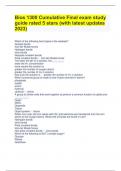
-
Bios 1300 Cumulative Final exam study guide rated 5 stars (with latest updates 2023)
- Other • 26 pages • 2023
- Available in package deal
-
- $11.99
- + learn more
Bios 1300 Cumulative Final exam study guide rated 5 stars (with latest updates 2023) Which of the following bond types is the weakest? Isotopic bonds Van der Waals forces Hydrogen bonds Ionic bonds Nonpolar covalent bonds Polar covalent bonds - Van der Waals forces The lower the pH of a solution, the ________. lower the H+ concentration more neutral the solution is greater the number of oxygen atoms greater the number of H+ in solution less toxic the solution is - greater ...
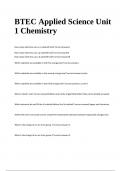
-
BTEC Applied Science Unit 1 Chemistry - Distinction.
- Exam (elaborations) • 31 pages • 2024
-
- $13.99
- + learn more
BTEC Applied Science Unit 1 Chemistry - Distinction. How many electrons can an s subshell hold? correct answer2 How many electrons can a p subshell hold? correct answer6 How many electrons can a d subshell hold? correct answer10 Which subshells are available in the first energy level? correct answers Which subshells are available in the second energy level? correct answers and p Which subshells are available in the third energy level? correct answers, p and d What is Hund's rule? correct ...

-
Biochemistry FAU Haces Exam 1 Questions and Answers Fully Solved 100%
- Exam (elaborations) • 16 pages • 2024
- Available in package deal
-
- $7.99
- + learn more
________ reacts with amino groups to form shift bases - aldehyde 8. What volume of 2 M HCl is required to completely titrate a 4 mmol monosodium aspartate (Asp.Na) solution? a. 2 ml b. 3 ml c. 4 ml d. 6 ml or more - C; 2x4 = 8 /2 = 4 ml A 42-amino acids peptide related to the extracellular Alzheimer amyloid deposits has the last few residues immersed in the membrane bilayer(must be nonpolar). Based on your knowledge about membrane proteins, which of the following sequences most probabl...
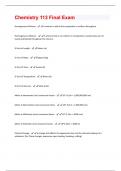
-
Chemistry 113 Final Exam Questions Perfectly Answered!!
- Exam (elaborations) • 8 pages • 2024
- Available in package deal
-
- $7.99
- + learn more
Homogeneous Mixture - A mixture in which the composition is uniform throughout Heterogeneous Mixture - A mixture that is not uniform in composition; components are not evenly distributed throughout the mixture. SI Unit of Length - Meter (m) SI Unit of Mass - Kilogram (kg) SI Unit of Time - Second (s) SI Unit of Temperature - Kelvin (K) SI Unit of Amount - Mole (mol) Meter to Nanometer (nm) conversion factor - 10^-9 (1m = 1,000,000,000 nm) Meter to Micrometer (um) conversion factor - 10^...
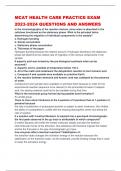
-
MCAT HEALTH CARE PRACTICE EXAM 2023-2024 QUESTIONS AND ANSWERS
- Exam (elaborations) • 50 pages • 2024
-
- $19.49
- + learn more
MCAT HEALTH CARE PRACTICE EXAM QUESTIONS AND ANSWERS In the chromatography of the reaction mixture, since water is absorbed in the cellulose functioned as the stationary phase. What is the principal factor determining the migration of individual components in the sample? a. Hydrogen bonding b. Solute concetration c. Stationary phase concetration d. Thickness of the paper Hydrogen bonding because the relative amount of hydrogen bonding to the stationary phase will determine the relative r...
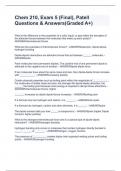
-
Chem 210, Exam 5 (Final), Patell Questions & Answers(Graded A+)
- Exam (elaborations) • 7 pages • 2024
- Available in package deal
-
- $14.99
- + learn more
What is the difference in the properties of a solid, liquid, or gas reflect the strengths of the attractive forces between the molecules that make up each phase? - ANSWERintermolecular forces What are the examples of intermolecular forces? - ANSWERdispersion, dipole-dipole, hydrogen bonding Dipole-dipole interactions are attractive forces that act between ______ molecules. - ANSWERpolar Polar molecules have permanent dipoles. The positive end of one permanent dipole is attracted to the ...
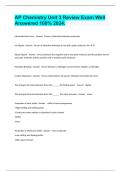
-
AP Chemistry Unit 3 Review Exam Well Answered 100% 2024.
- Exam (elaborations) • 4 pages • 2024
-
Available in package deal
-
- $7.99
- + learn more
Intermolecular Forces - Answer Forces of attraction between molecules ion-Dipole - Answer Forces of attraction between an ion and a polar molecule. Na+ & Cl- Dipole-Dipole - Answer Forces between the negative end of one polar molecule and the positive end of one polar molecule and the positive end of another polar molecule. Hydrogen Bonding - Answer Forces between a Hydrogen and a Fluorine, Oxygen, or Nitrogen London Dispersion - Answer Forces exist between all species. Wea...
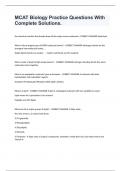
-
MCAT Biology Practice Questions With Complete Solutions.
- Exam (elaborations) • 55 pages • 2024
-
Available in package deal
-
- $12.99
- + learn more
MCAT Biology Practice Questions With Complete Solutions. the chemical reaction that breaks down all the major macro-molecules - CORRECT ANSWER Hydrolysis What is the strongest type of INTER-molecular bonds? - CORRECT ANSWER Hydrogen bonds are the strongest intermolecular bonds.... diople-dipole bonds are weaker. . . Vander wall bonds are the weakest. Why is water a liquid at high temperatures? - CORRECT ANSWER Hydrogen bonding bonds the water molocules closer together. What is an ...
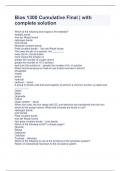
-
Bios 1300 Cumulative Final | with complete solution
- Exam (elaborations) • 26 pages • 2023
-
- $10.49
- + learn more
Bios 1300 Cumulative Final | with complete solution Which of the following bond types is the weakest? Isotopic bonds Van der Waals forces Hydrogen bonds Ionic bonds Nonpolar covalent bonds Polar covalent bonds - Van der Waals forces The lower the pH of a solution, the ________. lower the H+ concentration more neutral the solution is greater the number of oxygen atoms greater the number of H+ in solution less toxic the solution is - greater the number of H+ in solution Which fun...
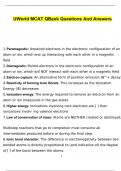
-
UWorld MCAT QBank Questions Missed Exam Questions And Answers
- Exam (elaborations) • 11 pages • 2024
-
- $9.49
- + learn more
UWorld MCAT QBank Questions Missed Exam Questions And Answers Paramagnetic - answerUnpaired electrons in the electronic configuration of an atom or ion, which end up interacting with each other in a magnetic field Diamagnetic - answerPaired electrons in the electronic configuration of an atom or ion, which will NOT interact with each other in a magnetic field Electron capture - answerAn alternative form of positron emission (B^+ decay) Reactivity of forming Ionic Bonds - answerThis increases as ...

How did he do that? By selling his study resources on Stuvia. Try it yourself! Discover all about earning on Stuvia


